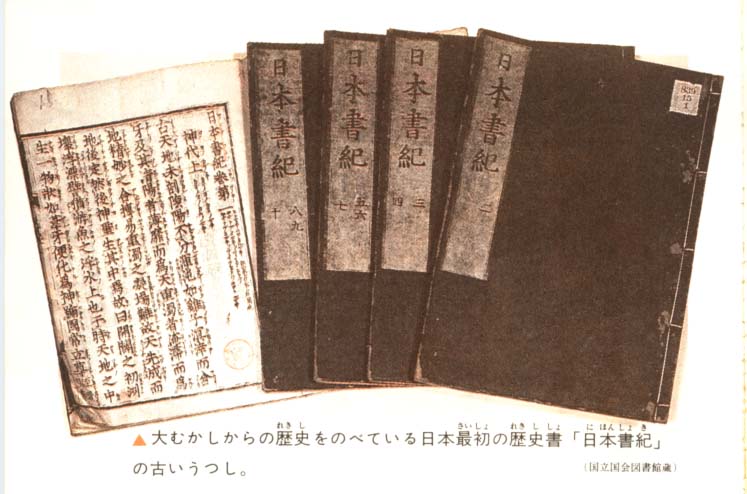Imperial Family of Japan and the Japanese Myth
No European kings and queens claim that their ancestors were gods, but the imperial court of Japan officially asserted that the emperor was a descendant of gods in the official history book formulated in the early 8th century or specifically in 720. And this official history book, which actually contains myths and facts, has never been denied to date, though the Japanese Constitution and laws and regulations of today do not admit or accept the authority of the emperor based on the book, titled Nihon-shoki (the Record Book of Japan).
According to Nihon-shoki, the first emperor, called Jin-mu (meaning god's military force), was born as a son of a god called Hiko-nagisatake-ugaya-hukiaezu, in a region called Hyuga, presently Miyazaki Prefecture in Kyusyu. The first god who descended from the heaven to Hyuga was called Ninigi. Ninigi was a grandson of goddes Ama-terasu-omikami who was a daughter of Izanagi. Izanagi was one of the seven gods who were born at the time of the creation of the world. Among them, Ama-terasu-omikami was regarded as the direct ancestor of the imperial family that was started by Emperor Jin-mu. Today, Ama-terasu-omikami is enshrined in the Ise Shrine in Mie Prefecture. Even today, every Japanese prime minister goes to the Ise Shrine to pay respect to goddes Ama-terasu-omikami in the first week in January.
And the current emperor is the 125th emperor, meaning the 124th emperor after the first emperor Jin-mu who was a descendant of goddess Ama-terasu-omikami (meaning a great goddess shining in the sky). According to the history book Nihon-shoki, Jin-mu reigned Japan from January 1, BC 660, for 77 years. The Japanese imperial calendar specifies BC 660 as the first year in the Japanese history, though this calendar is only used in shinto shrines.
In China where different powerful families sometimes launched revolution to defeat incumbent imperial families to establish new dynasties, whenever a new dynasty was established they started to write and compile a new history book to justify their act of taking over power. But in Japan, only one family has ever occupied the imperial court or the dynasty of Japan. Therefore, Nihon-shoki is the only history book written and compiled by dynasties of Japan that have been actually only one.
If any powerful clan had tried to replace the imperial family of Japan in the past, they should have had to create a new myth of Japan with new gods and goddesses. It must have been a very difficult task, since Nihon-shoki consists of 30 volumes. And for example, the first volume, which describes an era of gods and goddesses, consists of 13,500 kanji letters. To create a new history book of Japan to justify their authority, a new ruler of Japan should have written a longer and richer history than Nihon-shoki. It is almost impossible. Accordingly, though the imperial family and the emperor lost political power before the 10th century, no ruling noble families or samurai clans in later eras tried to abolish the incumbent imperial family and establish a new dynasty.
So, very nominally the imperial family of Japan is a descendant of gods and goddesses even today.
However, Nihon-shoki was written in classic Chinese. It was not written in the Japanese language. Nihon-shoki consists of classic Chinese sentences. Therefore, the letters used in the history book are all kanji (Chinese) characters. (Though Japanese sentences came to be written with kanji and kana characters, till kana characters were invented based on kanji in the 9th century, Japanese sentences were also written with only kanji characters.) Nihon-shoki was formulated for the purpose of showing it to the Chinese imperial court. It was intended to show to Chinese that the Japanese imperial court was cultivated as much as China, the overwhelmingly most advanced country in East Asia at the time. It is as if a small country wrote its constitution in English to show the US that the country is cultivated as much as the US.
However, in the 8th century, as China was so dominant in East Asia, most of other countries became tributary nations of China. But Japan declared in the 8th century that it was not subject to China, since the Japanese imperial court could write its history in decent Chinese like the Chinese imperial court. Indeed, even Romans used ancient Greeks to show how much they were cultivated.
This is a key to understanding the Japanese culture and tradition as well as its history. And that is why the imperial family of Japan has survived for 1700 years, as proven by some historical facts. (A classic Chinese history book made description about a state of Japan of around AD 1, which is the earliest written record about Japan.)
Put simply, the imperial family of Japan has its own myth that is also a myth of Japan.

Copy of Nihon-shoki (part of the total 30 volumes)
**** **** ****
Luk 3:9 And now also the axe is laid unto the root of the trees: every tree therefore which bringeth not forth good fruit is hewn down, and cast into the fire.
